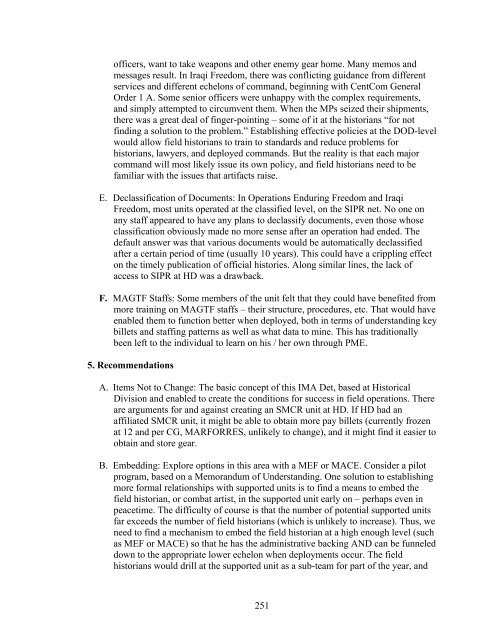Marine History Operations in Iraq Operation Iraqi Freedom I PCN ...
Marine History Operations in Iraq Operation Iraqi Freedom I PCN ...
Marine History Operations in Iraq Operation Iraqi Freedom I PCN ...
You also want an ePaper? Increase the reach of your titles
YUMPU automatically turns print PDFs into web optimized ePapers that Google loves.
officers, want to take weapons and other enemy gear home. Many memos and<br />
messages result. In <strong>Iraq</strong>i <strong>Freedom</strong>, there was conflict<strong>in</strong>g guidance from different<br />
services and different echelons of command, beg<strong>in</strong>n<strong>in</strong>g with CentCom General<br />
Order 1 A. Some senior officers were unhappy with the complex requirements,<br />
and simply attempted to circumvent them. When the MPs seized their shipments,<br />
there was a great deal of f<strong>in</strong>ger-po<strong>in</strong>t<strong>in</strong>g – some of it at the historians “for not<br />
f<strong>in</strong>d<strong>in</strong>g a solution to the problem.” Establish<strong>in</strong>g effective policies at the DOD-level<br />
would allow field historians to tra<strong>in</strong> to standards and reduce problems for<br />
historians, lawyers, and deployed commands. But the reality is that each major<br />
command will most likely issue its own policy, and field historians need to be<br />
familiar with the issues that artifacts raise.<br />
E. Declassification of Documents: In <strong><strong>Operation</strong>s</strong> Endur<strong>in</strong>g <strong>Freedom</strong> and <strong>Iraq</strong>i<br />
<strong>Freedom</strong>, most units operated at the classified level, on the SIPR net. No one on<br />
any staff appeared to have any plans to declassify documents, even those whose<br />
classification obviously made no more sense after an operation had ended. The<br />
default answer was that various documents would be automatically declassified<br />
after a certa<strong>in</strong> period of time (usually 10 years). This could have a crippl<strong>in</strong>g effect<br />
on the timely publication of official histories. Along similar l<strong>in</strong>es, the lack of<br />
access to SIPR at HD was a drawback.<br />
F. MAGTF Staffs: Some members of the unit felt that they could have benefited from<br />
more tra<strong>in</strong><strong>in</strong>g on MAGTF staffs – their structure, procedures, etc. That would have<br />
enabled them to function better when deployed, both <strong>in</strong> terms of understand<strong>in</strong>g key<br />
billets and staff<strong>in</strong>g patterns as well as what data to m<strong>in</strong>e. This has traditionally<br />
been left to the <strong>in</strong>dividual to learn on his / her own through PME.<br />
5. Recommendations<br />
A. Items Not to Change: The basic concept of this IMA Det, based at Historical<br />
Division and enabled to create the conditions for success <strong>in</strong> field operations. There<br />
are arguments for and aga<strong>in</strong>st creat<strong>in</strong>g an SMCR unit at HD. If HD had an<br />
affiliated SMCR unit, it might be able to obta<strong>in</strong> more pay billets (currently frozen<br />
at 12 and per CG, MARFORRES, unlikely to change), and it might f<strong>in</strong>d it easier to<br />
obta<strong>in</strong> and store gear.<br />
B. Embedd<strong>in</strong>g: Explore options <strong>in</strong> this area with a MEF or MACE. Consider a pilot<br />
program, based on a Memorandum of Understand<strong>in</strong>g. One solution to establish<strong>in</strong>g<br />
more formal relationships with supported units is to f<strong>in</strong>d a means to embed the<br />
field historian, or combat artist, <strong>in</strong> the supported unit early on – perhaps even <strong>in</strong><br />
peacetime. The difficulty of course is that the number of potential supported units<br />
far exceeds the number of field historians (which is unlikely to <strong>in</strong>crease). Thus, we<br />
need to f<strong>in</strong>d a mechanism to embed the field historian at a high enough level (such<br />
as MEF or MACE) so that he has the adm<strong>in</strong>istrative back<strong>in</strong>g AND can be funneled<br />
down to the appropriate lower echelon when deployments occur. The field<br />
historians would drill at the supported unit as a sub-team for part of the year, and<br />
251
















